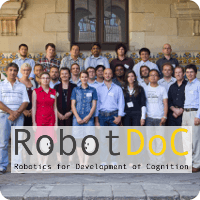
RobotDoC Robotics for Development of Cognition
Coordinator (PI): University of Plymouth, UK
Start Date: 1st September 2009
End Date: 1st September 2014
Funded by FP7-PEOPLE-ITN-2008 - Marie Curie Action Networks for Initial Training
Project Code or Grant Number: 235065
The RobotDoC Collegium is a multi-national doctoral training network for the interdisciplinary training on developmental cognitive robotics. The RobotDoC Fellows develop advanced expertise of domain-specific robotics research skills and of complementary transferrable skills for careers in academia and industry. They acquire hands-on experience through experiments with the open-source humanoid robot iCub, complemented by other existing robots available in the network's laboratories.
The RobotDoC project is divided into seven "nodes", Body, Brain, Feel and Want, See and Act, You and I, Think and Talk, Grow. The Knowledge Technology Group is in charge of the "Brain" node integrating new principles of brain-inspired learning in embodied cognitive robots. Two research lines are being address in this node, "Neural Emotion and Action Integration" and "Neural Cognitive Integration".
The RobotDoC Collegium is co-financed by the European Commission under the Marie Curie Initial Training Networks and under the 7th Framework Programme (FP7) for Research and Technological Development.

Neurocomputational Mechanisms for Self-Protective Robot Behaviour
Self-protective neural circuits belong to the most important and essential capabilities of any organism. They are believed to provide the basis for more complex and motivated behaviour. Although many of these innate responses are hard-coded in the brain, they are not sufficient for the organisms' survival. They have to adapt to new and unexpected situations within their lifetime and thereby be able to interact effectively with their environment. A key component of the lifetime adaptation is the formation of associations between environmental predictors and relevant events, which may be learned with punishment and reward learning. We hypothesize that a deeper understanding and integration of innate and learned protective mechanisms could be helpful in developing future robot generations, making them more adaptable and robust.
In this research project, we are studying and developing neurocomputational self-protective mechanisms for a humanoid service robot such as association of appetitive stimuli and more importantly associations of aversive or noxious stimuli. Our first experiment addresses reward-driven learning where a robot is trained to seek for appetitive stimuli. Here a reinforcement learning (SARSA) algorithm is optimized to learn in a real-world scenario and manoeuvre a humanoid robot towards a charging station. In a second experiment we study the role of noxious stimuli on the formation of anticipatory behaviour. This experiment is based on Pavlovian and instrumental conditioning and how environmental cues can be used to anticipate negative outcomes. A hybrid approach using an echo state network (ESN) and a dopamine modulated Pavlovian conditioning was used to anticipate painful signal based on auditory cues. Finally, our current research focuses on emulated pain signals due to their important role in attracting attention and modulating decision making and action. Pain is an unpleasant sensory experience associated with actual or potential damage and thus a strong indicator for behaviour readjustment. However maladaptive behaviours may arise leading to persistent avoidance behaviour and ironically to more pain and long-term disability. Particularly, we are studying the boundaries between adaptive and maladaptive withdrawal behaviours in a motor learning task. We design, implement and evaluate an actor-critic learning algorithm (CACLA) which can learn to teach a humanoid robot to reach for a moving target.
Acknowledgments:
This research has been partly supported by the EU project RobotDoC under 235065 ROBOT-DOC from the 7th Framework Programme, Marie Curie Action ITN.Project Partners:
- University of Plymouth, UK
- University of Zurich
- Istituto Italiano di Tecnologia – IIT
- Högskolan i Skövde
- Universität Bielefeld
- Universität Hamburg
- Uppsala universitet
- Telerobot Ocem
- Telerobot SpA